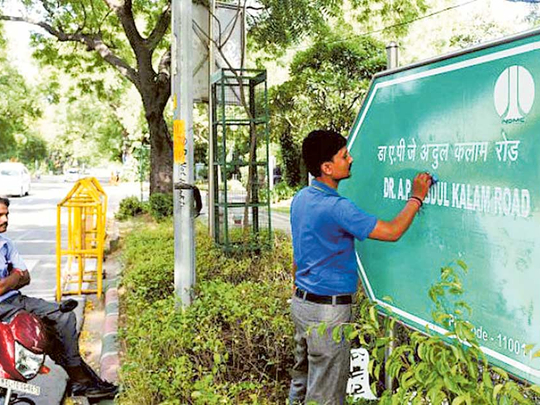
New Delhi: Despite being renamed decades ago, many British-era streets and institutions across the country retain their original identity in people’s consciousness even as rechristening of several public places has bred confusion between the old and the modern generations.
Anuradha Reddy, 69, still looks for Willingdon Hospital and Willingdon Airport whenever she visits Delhi from Hyderabad, only to get quizzical looks from auto-rickshaw drivers.
“Autowallahs just give me a blank stare whenever I tell them to take me towards Willingdon Hospital [now RML Hospital] or Willingdon Airport [now Safdarjung Airport] flyover, as if I am imagining something. I have been visiting Delhi often and for me and my mother, the new names never come on the lips,” she told PTI.
Reddy, convener of the Hyderabad Chapter of Delhi-based Indian National Trust for Art and Culture (Intach), says, “renaming exercises” have “robbed” various vibrant cities of their character, and created confusion among people.
“I still use Bombay and Calcutta, but my children say Mumbai and Kolkata. And, Bangalore was changed to Bengaluru, I find it silly. In next 10 years, children growing up would not know the historical connect,” she said.
While old-timers and new generations may be experiencing a communication gap on ‘Willingdon’ and ‘RML’ nomenclatures, the capital city’s iconic ‘Connaught Place’ continues to enjoy its original identity in the consciousness of people, of all age.
In Patna too, several colonial-era street names still are referred to by their old monikers, even though they were rechristened after Independence. The famous ‘Bailey Road’, ‘Fraser Road’, ‘Mangles Road’, ‘Circular Road’, ‘Strand Road’ and ‘Hardinge Road’ are still in vogue.
“If you ask anybody in Patna where is Jawaharlal Nehru Marg, I am sure, no one would be able to guide, but if you ask directions for Bailey Road, every single person would do so.
“The idea of renaming a street is foolish, politicians and government should focus on town planning and making the city better for citizens, not fiddling with historical names,” says octogenarian S K Sinha, former chief town planner of Bihar.
In Delhi, the ‘Aurangzeb Road’ was earlier rechristened to ‘Dr APJ Abdul Kalam’ and the ‘Race Course Road’ was recently renamed as ‘Lok Kalyan Marg’ drawing sharp reactions from various quarters. The DMRC has also renamed ‘Race Course Metro Station’ in line with the new identity.
Intach Delhi convener and noted architect AGK Menon says, renaming “destroys” the character of a city.
“A city like Delhi has multiple layers of history. By renaming the streets and places, slowly those layers are being erased. Politicians resort to such quixotic ideas to earn a few populist brownie points.
“They can very well build new roads or start scholarships and schemes in the name of great personalities, but, that will involve real work. So, it is like picking the lowest fruits in the branch,” he said.
Kolkata-based heritage activist Anthony Khatchaturian, who still prefers to call the city Calcutta, says, “Although one can understand the need to honour our own native trail blazers, this needs to be balanced with maintaining our identity both locally and globally.”
He conducts regular heritage walks in the former capital of India, to let people know and celebrate the history of the city.
“From iconic Park Street [now Mother Teresa Sarani] to Lower Circular Road [Acharya Jagadish Chandra Bose Road], renaming list in Calcutta is endless. But it hasn’t stopped with streets, our entire Metro network has been renamed, like Tollygunge renamed to ‘Mahanayak Uttam Kumar’ station. But, people still use the old names,” he said.
“Renaming has led to abject confusion with tourists who wish to see the places they have heard and read about. Locals are equally confused and anyone getting in the Metro is utterly confused,” Khatchaturian adds.
But renaming, besides breeding confusion among people, has another flip side to it, postal woes.
After the recent renaming of the ‘Aurangzeb Road’ in Delhi, many residents there still continue to use the old moniker on the household nameplates and in writing the address.
“The renaming benefits the sign board painters and gets some brownie points for politicians, but postmen have a tough time, as they are used to old addresses. And people looking for someone’s house find it a tad difficult too,” said a resident of the renamed street, who did not wish to be identified.
Hyderabad-based Reddy says post-colonial renaming have created so much confusion that parallel names have come up, not to speak of the “loss of the historical context” with the erasure of the old names.
“In Secunderabad, the historic James Street was renamed to Mahatma Gandhi Road. In Hyderabad, famous Abid Road was changed to M G Road, creating confusion in the twin cities. More so, a statue of Nehru was installed somewhere in the middle and some people started calling it J L Nehru Road.
“So, not only history has been robbed through this meaningless exercise, people’s clarity on city navigation has also been compromised,” she said.
79-year-old R V Smith, author and perhaps the most famed chronicler of modern Delhi, said streets and parks are renamed just on the “whim and fancy of some politicians.”










